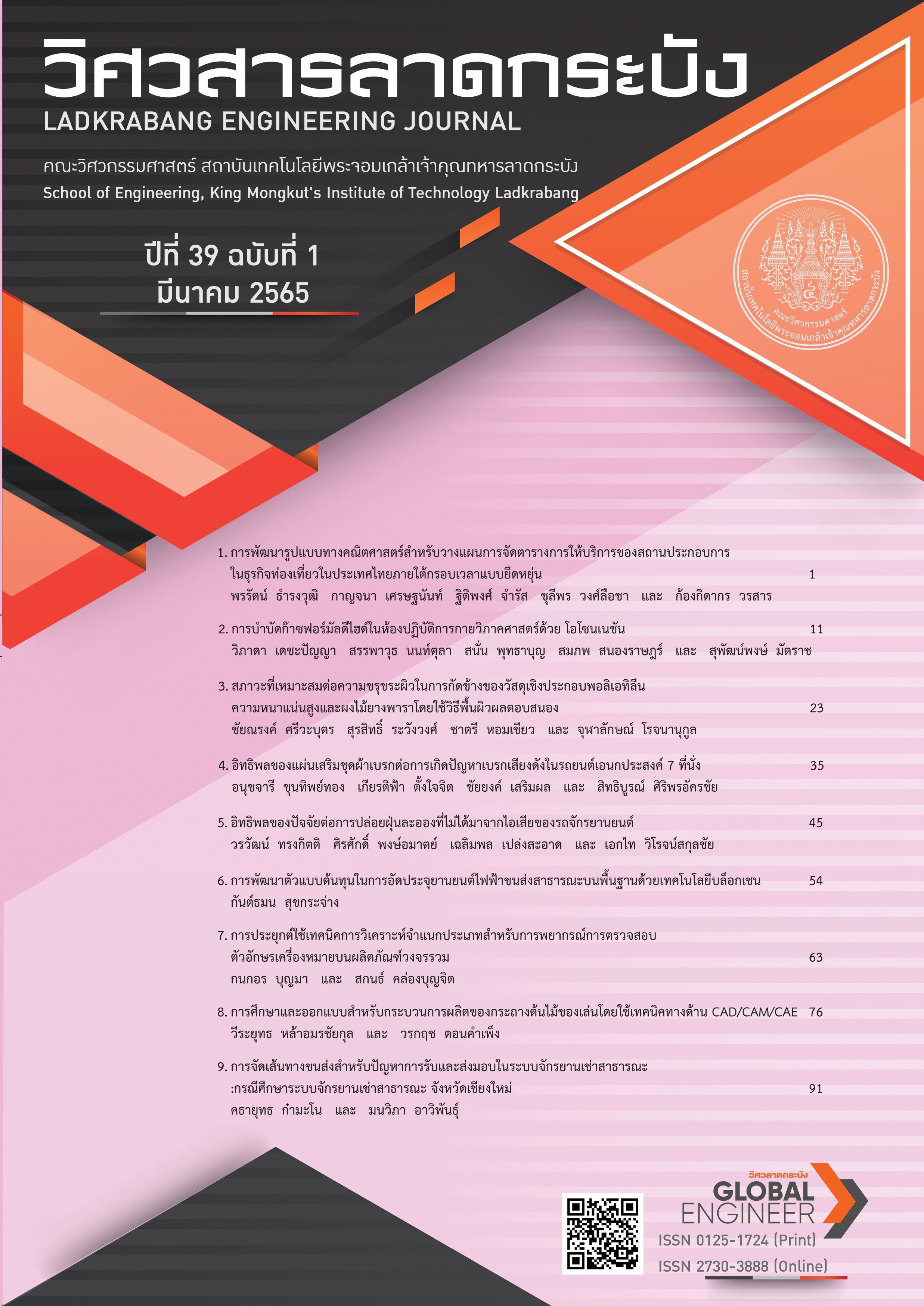Influence of Factors on Non-Exhaust PM Emissions from Motorcycle
Keywords:
Particulate Matter from motorcycle, Non-Exhaust PM Emissions, Real-time PM MeasurementAbstract
Over past several years, many countries all around the world have encountered air pollution problems. PM (Particulate Matter) is one of the most problematic air pollutants that seriously harms human health and the environment. The major source of PM emissions is from automobiles due to the combustion process emitted via tailpipe. However, PM can also emit from non-exhaust sources, such as tyre wear, brake wear, and resuspension, which are referred to as non-exhaust PM emissions. These types of PM are not only emitted from automobiles but also from motorcycles. Based on statistics data from Department of Land Transport, it was shown that in 2019, Thailand had motorcycles registered about 62% of total registered vehicles. This research study is aimed on measuring non-exhaust PM emissions including PM1, PM2.5 and PM10 that emitted by motorcycles. An onboard PM measuring device is attached on the front wheel of the tested motorcycle to monitor PM diffusion while braking. Based on experimental results, it is found out that the main factor that affects the diffusion of non-exhaust PM emissions is the braking behavior. With harder braking, more PM diffusions are produced. Different weather conditions also affect the accumulation of PM. High relative air humidity results in higher PM diffusions. When the payload of a motorcycle increases, the amount of PM diffusion increases as well. Lastly, road conditions also affect the amount of emitted PM. When the road surface is rough, it clearly increases PM diffusion.
References
European Environmental Agency, “Air Quality in Europe-2014 Report,” EEA, Copenhagen, Denmark, 5/2014, Aug. 3, 2015. [Online] Available: http://www.eea.europa.eu/publications/air-quality-in-europe-2014.
U. Gehring, R. Beelen, M. Eeftens, et al, “Particulate matter composition and respiratory health: the PIAMA Birth Cohort Study,” Epidemiology, vol. 26, no. 3, 2015, doi: 10.1097/EDE.0000000000000264.
R. O Salonen, A. I. Hälinen, A. S. Pennanen et al, “Chemical and in vitro toxicologic characterization of wintertime and springtime urban-air particles with an aerodynamic diameter below 10 mm in Helsinki,” Scandinavian Journal of Work Environment & Health, vol. 30, no. 2, pp. 80–90.
B. Brunekreef, B. Forsberg, “Epidemiological evidence of coarse airborne particles on health,” European Respiratory Journal, vol. 26, no. 2, pp. 309–318, doi: 10.1183/09031936.05.00001805.
P. G. Boulter, “A Review of Emission Factors and Models for Road Vehicle Nonexhaust Particulate Matter,” TRL Limited, Berkshire, United Kingdom, PPR065, 2005.
A. Thorpe, R. M. Harrison, “Sources and properties of non-exhaust particulate matter from road traffic: a review,” Science of the Total Environment, vol. 400, no. 1–3, pp. 270–282, 2008, doi: 10.1016/j.scitotenv.2008.06.007.
M. Mathissen, V. Scheer, R. Vogt, T. Benter, “Investigation on the potential generation of ultrafine particles from the tire-road interface,” Atmospheric Environment, vol. 45, no. 34, pp. 6172–6179, 2011, doi:10.1016/j.atmosenv.2011.08.032.
V. R. J. H. Timmers and P. A. J. Archten, “Non-exhaust PM Emissions from Electric Vehicles,” Atmospheric Environments, vol. 134, pp. 10–17, 2016, doi: 10.1016/j.atmosenv.2016.03.017.
R. M. Harrison, A. M. Jones, J. Gietl, J. Yin, D. C. Green, “Estimation of the contribu-tions of brake dust, tire wear, and resuspension to non-exhaust traffic particles de-rived from atmospheric measurements,” Environmental Science & Technology, vol. 46, no. 12, pp. 6523–6529, 2012, doi: 10.1021/es300894r.
J. H. J. Hulskotte, G. D. Roskam, H. A. C. Denier van der Gon, “Elemental composition of current automotive braking materials and derived air emission factors,” Atmospheric Environment, vol. 99, pp. 436–445, doi: 10.1016/j.atmosenv.2014.10.007.
Transport Statistics, Transport Statistics Sub-Division, Aug. 5, 2020, [Online]. Available: https://web.dlt.go.th/statistics/
H. Hagino, M. Oyama and S. Sasaki, “Laboratory testing of airborne brake wear particle emissions using a dynamometer system under urban city driving cycles,” Atmospheric Environment, vol. 131, pp. 269–278, 2016, doi: 10.1016/j.atmosenv.2016.02.014
H. German, T. -A. Berry, W. Shannon and P. David, “Temperature and Humidity Effects on Particulate Matter Concentrations in a Sub-Tropical Climate during Winter,” in International Proceedings of Chemical, Biological and Environmental Engineering, 2017, pp. 41–49 doi:10.7763/IPCBEE.2017.V102.10.
A. Simons, “Road transport: new life cycle inventories for fossil-fuelled passenger cars and non-exhaust emissions in ecoinvent v3,” The International Journal of Life Cycle Assessment, vol. 21, no. 9, pp. 1–5, 2013, doi: 10.1007/s11367-013-0642-9.
J. Gillies, V. Etyemezian, H. Kuhns, D. Nikolic and D. A. Gillette, “Effect of vehicle characteristics on unpaved road dust emissions,” Atmospheric Environmentl, vol. 39, no. 13, pp. 2341–2347, doi: 10.1016/j.atmosenv.2004.05.064.
Determinants of rear-of-wheel and tire-road wear particle emissions by light-duty vehicles using on-road and test track experiments
Choked flow, Nertrium, 2015 [Online]. Available: https://neutrium.net/fluid-flow/choked-flow/
R. Trentini, E. Guilherme, C. Alexandre, S. S. Antonio, “Modeling and parameter identification of a pneumatic pressure valve using least squares and particle swarm optimization methods,” in 22nd International Congress of Mechanical Engineering, SP, Brazil, Nov. 3–7, 2013.
Don't Be Fazed By Multiphase Sampling, S. Andrew , 2012 [Online]. Available: https://www.chemicalprocessing.com/articles/2012/don-t-be-fazed-by-multiphase-sampling/
Downloads
Published
How to Cite
Issue
Section
License
Copyright (c) 2022 Faculty of Engineering, King Mongkut’s Institute of Technology Ladkrabang

This work is licensed under a Creative Commons Attribution-NonCommercial-NoDerivatives 4.0 International License.
The published articles are copyrighted by the School of Engineering, King Mongkut's Institute of Technology Ladkrabang.
The statements contained in each article in this academic journal are the personal opinions of each author and are not related to King Mongkut's Institute of Technology Ladkrabang and other faculty members in the institute.
Responsibility for all elements of each article belongs to each author; If there are any mistakes, each author is solely responsible for his own articles.






